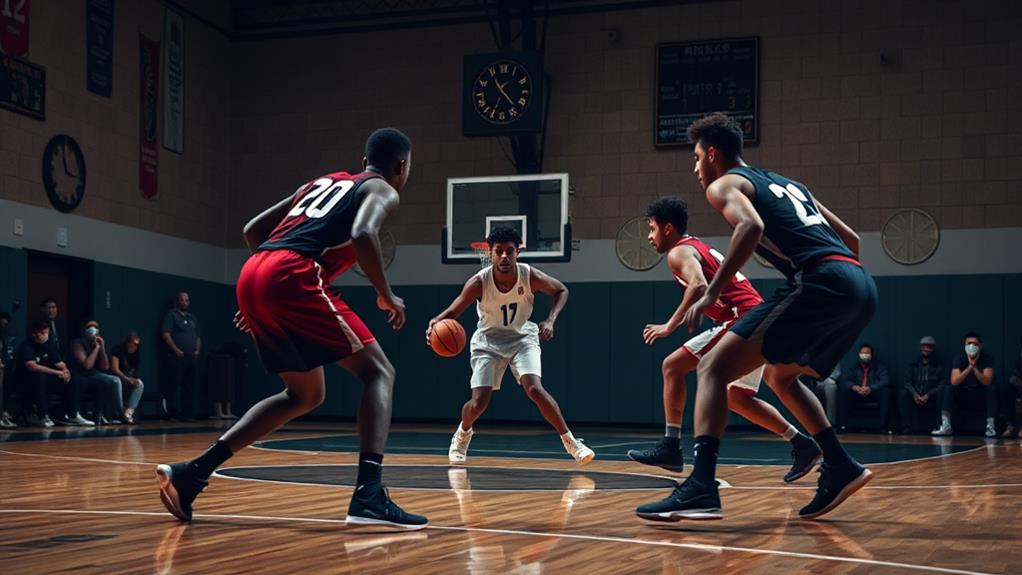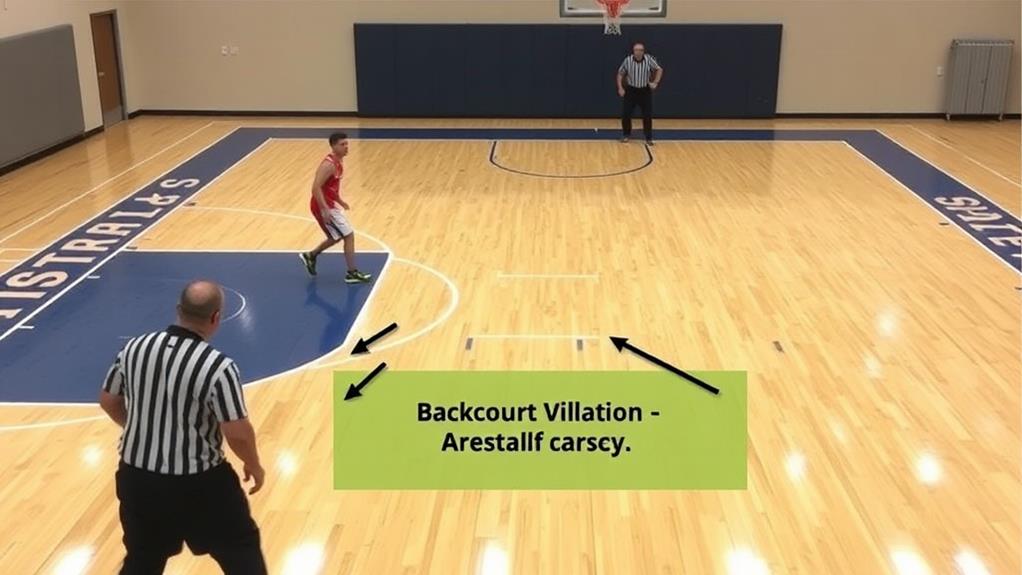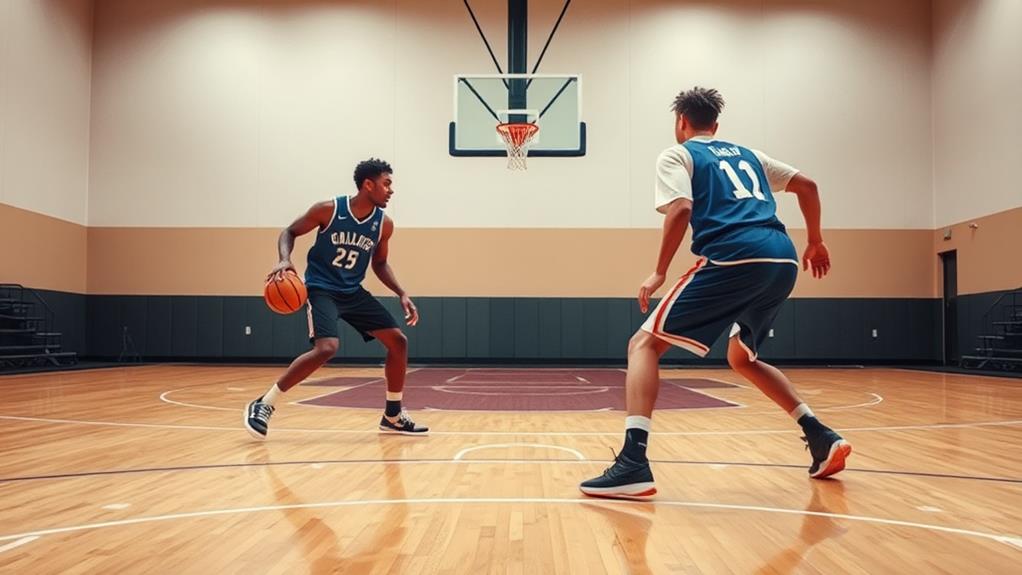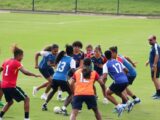
What Is a Backcourt Violation in Basketball and How to Avoid It
October 1, 2024A backcourt violation happens when your team returns the ball to the backcourt after gaining control in the frontcourt. To avoid this, guarantee both your feet cross the midcourt line before you touch the ball again in the backcourt. Be mindful of the 10-second rule after an inbound pass—advance the ball past midcourt quickly. It's also essential to understand the last player to touch the ball and remain aware of your teammates' positions. Mastering these tips can keep your game flowing smoothly. There's plenty more to help you sharpen your skills and avoid costly mistakes.
Understanding Backcourt Violations
Understanding backcourt violations is vital for any basketball player or fan. A backcourt violation occurs when your team returns the ball to the backcourt after establishing control in the frontcourt, resulting in a turnover. This violation can only be called if your team has team control, meaning you last touched the ball in the frontcourt before it crosses back into the backcourt.
As defensive strategies evolve, players must enhance their awareness of court positioning to avoid unintentional violations, especially when facing aggressive defensive tactics that may pressure ball handlers. The violation is triggered when an offensive player from your team first touches the ball in the backcourt. To avoid this situation, you need to guarantee that the ball is advanced past the midcourt line within 10 seconds after a throw-in.
Clear communication and awareness of your teammates' positioning are vital, especially during high-pressure situations, as emphasized in modern defensive approaches to disrupt offensive flow historical shifts in defensive approaches.
Knowing the basketball rules surrounding backcourt status can help you maintain control of the basketball and prevent unnecessary turnovers. When you're aware of where you're on the court, you can effectively manage your team's movements and avoid touching a player in the backcourt, which would lead to a violation.
Understanding these aspects will greatly improve your game awareness and decision-making on the court.
Factors for Backcourt Status
Several key factors determine backcourt status in basketball, and being aware of them can greatly impact your gameplay.
First, you need to understand that your team must achieve frontcourt status by having both feet fully cross the midcourt line. If any part of your feet remains in the backcourt, you still retain backcourt status. The evolution of court dimensions and markings, including the introduction of the three-point line, has also influenced game dynamics and player positioning.
Clear possession of the ball is essential; you can't be dribbling the ball in the frontcourt and then have a player touch it in the backcourt without first establishing control. The last player to touch the ball in the frontcourt must also be the first to touch it in the backcourt for a violation to be called.
Moreover, if your opponent deflects the ball and it goes back into the backcourt, there's no violation since team control isn't lost. This means you can retrieve the ball without penalty.
Always keep these factors in mind to avoid unnecessary turnovers. Being mindful of your team's position, the ball's status, and player control will help you navigate the court effectively and minimize the risk of a backcourt violation.
Common Examples of Violations

You might encounter several common examples of backcourt violations during a game. One major issue occurs when a player touches the ball first in the backcourt after already establishing possession in the frontcourt.
This can often be avoided by understanding the rules and maintaining awareness of your team's positioning, which can provide a strategic advantage in avoiding penalties.
Additionally, inbound pass missteps and dribbling violations can easily lead to turnovers if you're not careful.
Player Touches Backcourt First
In basketball, a backcourt violation often occurs when a player touches the ball in the backcourt after it has crossed the midcourt line. To avoid these common pitfalls, you need to understand when you might be committing a violation as an offensive player.
Here are three situations to watch out for:
- Passing with Mistakes: If you're in the frontcourt and pass to a teammate who catches the ball in the backcourt, that's a clear backcourt violation. Make sure your passes stay within frontcourt status.
- Dribbling Errors: If you start dribbling the basketball from the frontcourt into the backcourt after your team has established control of the ball, you've committed a violation. Keep your dribbling contained.
- Catching and Landing: If you catch a pass while airborne and land in the backcourt, this results in a violation if you were the last to touch the ball in the frontcourt. Always be aware of your position when you touch the ball in the backcourt.
Inbound Pass Missteps
Understanding backcourt violations doesn't stop at player actions after the ball crosses midcourt; inbounding the ball also presents pitfalls that can lead to mistakes. One common misstep occurs when a player attempts an inbound pass and inadvertently passes the ball to a teammate already in the backcourt, resulting in a backcourt violation.
If an offensive player fumbles the inbound pass and the ball travels into the backcourt, it's not a violation as long as team control wasn't established during the inbound. However, if a player catches the ball while airborne and lands in the backcourt after receiving an inbound pass, it leads to a backcourt violation. To avoid this, confirm both feet are in the frontcourt upon landing.
Another mistake happens when a player catches the ball in the frontcourt but steps back over the midcourt line before establishing control. This also constitutes a backcourt violation, as their final touch occurred in the frontcourt.
Dribbling Violations Explained
Dribbling violations can turn a promising play into a costly turnover in basketball. Understanding these violations is essential for maintaining control of the ball and keeping your team in the game.
Here are three common dribbling violations to watch out for:
- Traveling: This occurs when a player takes more than two steps without dribbling the ball. If you find yourself moving with the ball, be mindful to either dribble or establish your front court quickly.
- Double Dribbling: This violation happens when you stop dribbling, then start again. Once you've halted your dribble, you can't resume it—doing so will lead to a turnover.
- Carrying the Ball: Also known as palming, this violation involves a player holding the ball too long in one hand while moving. Keep both hands on the ball to maintain control and avoid getting called out.
Legal Actions Misunderstood as Violations
You might think that certain actions on the court automatically lead to a backcourt violation, but that's not always the case.
For example, dribbling across midcourt or jumping and landing in the backcourt can be legal under specific conditions. Understanding these nuances can help you better grasp the rules and avoid confusion during the game.
In soccer, similar rules apply to guarantee fair play and strategy, such as the offside rule, which helps maintain a balanced game.
Dribbling Across Midcourt
Many players often confuse the rules surrounding dribbling across midcourt, leading to unnecessary turnovers. Understanding the nuances of backcourt and frontcourt status can help you avoid these costly mistakes.
Here are three key points to keep in mind:
- You can legally dribble the ball across the midcourt line as long as both your feet stay in the backcourt until the ball crosses into the frontcourt.
- Your backcourt status only changes when both your feet and the ball fully cross the midcourt line into the frontcourt.
- If you bounce the ball into the frontcourt without stepping over the midcourt line, you won't commit a violation.
Inbound Pass Scenarios
Inbound pass scenarios often lead to confusion, with players mistakenly thinking they've committed a backcourt violation. When you throw the ball in, it remains in the frontcourt until a player touches it. If the ball gets deflected into the backcourt, it's not a violation as long as the last touch was by your offensive team.
Remember, Team Control doesn't exist during the inbound process, so if you fumble the pass and it ends up in the backcourt, you're still in the clear.
If you catch an inbound pass while airborne and land with one foot in each court, you haven't committed a violation. Both the ball and the player must establish frontcourt status to trigger the backcourt rule.
Also, if you tip or bat the ball and it goes into the backcourt, it's still not a violation, since your offensive team retains control. Understanding that a defensive deflection allows the ball to return to the backcourt without a violation is key.
Jumping and Landing Rules
Jumping and landing in basketball can easily lead to misunderstandings regarding backcourt violations. To help you navigate these rules, here are three key points to remember:
- Catch with One Foot: You can legally catch the ball while jumping from the frontcourt if one foot is in the frontcourt and the other is in the backcourt. This doesn't result in a backcourt violation.
- Landing in the Backcourt: If you jump from the frontcourt and both feet land in the backcourt after catching the ball, that's a backcourt violation. Always be aware of where you land.
- Status of the Ball: The NFHS rules state that if the last player to touch the ball is from the offensive team and it goes into the backcourt, they can still regain control without penalty.
Understanding these jumping and landing rules can help you avoid unnecessary violations.
Always pay attention to your feet and the last player to touch the ball, as these factors determine whether you're safe or in violation territory.
Strategies to Prevent Violations

Preventing backcourt violations is essential for maintaining possession and momentum during a basketball game. To achieve this, your team must develop an internal countdown or timer to guarantee everyone crosses midcourt within the 10-second limit after an inbound pass. This reduces the risk of a 10-second violation.
Utilizing data-driven strategies can provide insights into player movement and positioning, further enhancing awareness on the court. Encourage players to maintain awareness of their positioning and the ball's status; once they establish control in the frontcourt, they should avoid dribbling or passing back into the backcourt.
Implement effective press-breaking strategies during practices to enhance ball movement and reduce pressure from defenders, which helps mitigate the chances of backcourt violations.
Emphasize teamwork and communication during gameplay; guarantee players are aware of each other's positions and intentions to prevent accidental violations. For instance, when a player jumps in the air to make a pass, they should clearly signal their intentions to their teammates.
Importance of Backcourt Rules
Understanding backcourt rules is essential for every player and coach, as they play a significant role in ensuring fair play and maintaining the game's flow. By grasping these rules, you can enhance your team's performance and avoid detrimental mistakes.
For example, just like in soccer where understanding the basic rules and structure is vital for gameplay, familiarity with backcourt rules can lead to better decision-making on the basketball court.
Here are three key reasons why backcourt rules matter:
- Fair Play: Backcourt rules prevent offensive teams from gaining an unfair advantage, ensuring that both teams have equal chances to control the game.
- Time Management: Knowing that you have 10 seconds to cross half court after an inbound pass helps you make quicker decisions, reducing the risk of a backcourt violation and maintaining momentum.
- Minimized Costly Turnovers: Backcourt violations result in deadball turnovers, handing over possession to the opposing team. Understanding player control and frontcourt status can help you avoid these costly mistakes.
Additionally, recognizing unique situations, like defensive deflections that allow the ball to return to the backcourt without penalty, can aid in strategic gameplay.
Embracing these aspects of backcourt rules ultimately leads to improved performance and fewer unnecessary errors on the court.
Conclusion
In summary, understanding backcourt violations is essential for any basketball player. Did you know that teams lose an average of 3% of their possessions each game due to these violations? By being aware of backcourt status and employing smart strategies, you can avoid these costly mistakes. Always stay alert and communicate with your teammates to keep the game flowing smoothly. Remember, a little awareness can make a big difference on the court!


